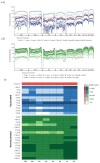Identification and Characterization of Swine Influenza Virus H1N1 Variants Generated in Vaccinated and Nonvaccinated, Challenged Pigs
- PMID: 34696517
- PMCID: PMC8539973
- DOI: 10.3390/v13102087
Identification and Characterization of Swine Influenza Virus H1N1 Variants Generated in Vaccinated and Nonvaccinated, Challenged Pigs
Abstract
Influenza viruses represent a continuous threat to both animal and human health. The 2009 H1N1 A influenza pandemic highlighted the importance of a swine host in the adaptation of influenza viruses to humans. Nowadays, one of the most extended strategies used to control swine influenza viruses (SIVs) is the trivalent vaccine application, whose formulation contains the most frequently circulating SIV subtypes H1N1, H1N2, and H3N2. These vaccines do not provide full protection against the virus, allowing its replication, evolution, and adaptation. To better understand the main mechanisms that shape viral evolution, here, the SIV intra-host diversity was analyzed in samples collected from both vaccinated and nonvaccinated animals challenged with the H1N1 influenza A virus. Twenty-eight whole SIV genomes were obtained by next-generation sequencing, and differences in nucleotide variants between groups were established. Substitutions were allocated along all influenza genetic segments, while the most relevant nonsynonymous substitutions were allocated in the NS1 protein on samples collected from vaccinated animals, suggesting that SIV is continuously evolving despite vaccine application. Moreover, new viral variants were found in both vaccinated and nonvaccinated pigs, showing relevant substitutions in the HA, NA, and NP proteins, which may increase viral fitness under field conditions.
Keywords: hemagglutinin (HA); neuraminidase (NA); next-generation sequencing; nonstructural protein (NS); nucleoprotein (NP); single nucleotide variants (SNVs); swine influenza virus (SIV).
Conflict of interest statement
The authors declare no conflict of interest.
Figures






Similar articles
-
Evolution of Swine Influenza Virus H3N2 in Vaccinated and Nonvaccinated Pigs after Previous Natural H1N1 Infection.Viruses. 2022 Sep 10;14(9):2008. doi: 10.3390/v14092008. Viruses. 2022. PMID: 36146814 Free PMC article.
-
Genetic diversification patterns in swine influenza A virus (H1N2) in vaccinated and nonvaccinated animals.Front Cell Infect Microbiol. 2023 Sep 15;13:1258321. doi: 10.3389/fcimb.2023.1258321. eCollection 2023. Front Cell Infect Microbiol. 2023. PMID: 37780850 Free PMC article.
-
[Swine influenza virus: evolution mechanism and epidemic characterization--a review].Wei Sheng Wu Xue Bao. 2009 Sep;49(9):1138-45. Wei Sheng Wu Xue Bao. 2009. PMID: 20030049 Review. Chinese.
-
Vaccination against swine influenza in pigs causes different drift evolutionary patterns upon swine influenza virus experimental infection and reduces the likelihood of genomic reassortments.Front Cell Infect Microbiol. 2023 Mar 13;13:1111143. doi: 10.3389/fcimb.2023.1111143. eCollection 2023. Front Cell Infect Microbiol. 2023. PMID: 36992684 Free PMC article.
-
Swine Influenza A Viruses and the Tangled Relationship with Humans.Cold Spring Harb Perspect Med. 2021 Mar 1;11(3):a038737. doi: 10.1101/cshperspect.a038737. Cold Spring Harb Perspect Med. 2021. PMID: 31988203 Free PMC article. Review.
Cited by
-
Does Vaccine-Induced Maternally-Derived Immunity Protect Swine Offspring against Influenza a Viruses? A Systematic Review and Meta-Analysis of Challenge Trials from 1990 to May 2021.Animals (Basel). 2023 Oct 3;13(19):3085. doi: 10.3390/ani13193085. Animals (Basel). 2023. PMID: 37835692 Free PMC article. Review.
-
Safety and Efficacy upon Infection in Sheep with Rift Valley Fever Virus ZH548-rA2, a Triple Mutant Rescued Virus.Viruses. 2024 Jan 5;16(1):87. doi: 10.3390/v16010087. Viruses. 2024. PMID: 38257787 Free PMC article.
-
Evolutionary analysis of Hemagglutinin and neuraminidase gene variation in H1N1 swine influenza virus from vaccine intervention in China.Sci Rep. 2024 Nov 20;14(1):28792. doi: 10.1038/s41598-024-80457-4. Sci Rep. 2024. PMID: 39567587 Free PMC article.
-
Sequence-Based Antigenic Analyses of H1 Swine Influenza A Viruses from Colombia (2008-2021) Reveals Temporal and Geographical Antigenic Variations.Viruses. 2023 Sep 30;15(10):2030. doi: 10.3390/v15102030. Viruses. 2023. PMID: 37896808 Free PMC article.
-
Evolution of Swine Influenza Virus H3N2 in Vaccinated and Nonvaccinated Pigs after Previous Natural H1N1 Infection.Viruses. 2022 Sep 10;14(9):2008. doi: 10.3390/v14092008. Viruses. 2022. PMID: 36146814 Free PMC article.
References
-
- Swine Influenza: OIE—World Organisation for Animal Health. [(accessed on 5 March 2021)]. Available online: https://www.oie.int/en/animal-health-in-the-world/animal-diseases/Swine-...
Publication types
MeSH terms
Substances
LinkOut - more resources
Full Text Sources
Miscellaneous

